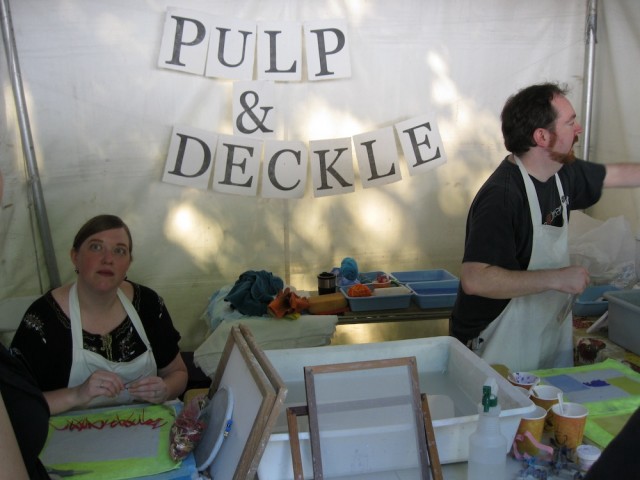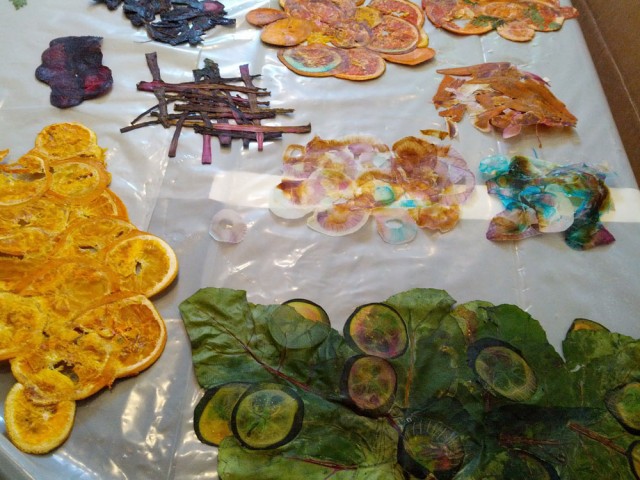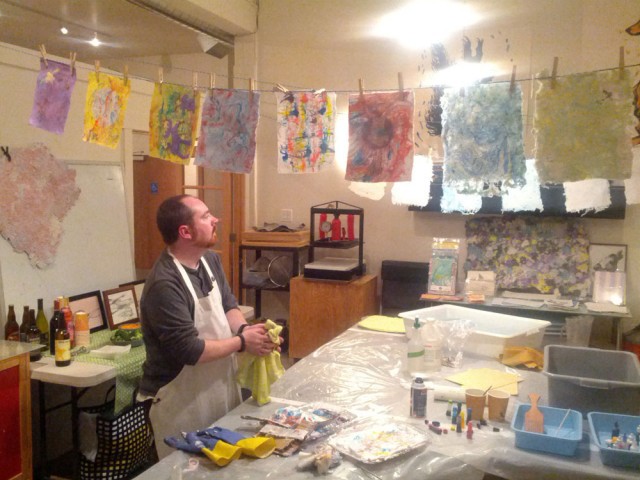Making Paper in a Paperless World: An Interview With Pulp and Deckle
by Christopher Tucker

In 2012, Jenn Woodward and Gary A. Hanson started a papermaking studio. Based out of Portland, Ore., Pulp and Deckle manufactures paper and gives workshops and classes about the process. Recently, I had an opportunity to chat with Jenn about her studio.
In a paperless world, you’re making paper. What was the impetus to start such a business?
A lot if it came from living here in Portland. There’s a vibrant small business culture, and there’s such an emphasis on “green.” The types of papermaking we’re doing (recycled paper, plant-based paper) is a slow, sustainable art form.
For me, a major part of the appeal is having a connection to how something is made. It transforms your understanding of it. When you go to the farmers market, or go to a woodworker’s furniture store, you’re voting with your dollars to say you want to connect with your food or your furnishings on a deeper level. You want to know who planted it, who carved it, etc. That’s what we’re all about.
I think papermaking is kind of magical. It’s one of those art forms that not many know about. I like showing people that something they take for granted in their everyday environment can be special and imbibed with meaning, beauty and purpose.
How’d you get into papermaking in the first place?
I first learned about papermaking while getting my MFA at the Museum School in Boston. I was doing a lot of drawing and mixed media work and got interested in making my own surfaces to work on. I got really into making onionskin papyrus…
Onionskin? Why onionskin?
Of all the fruit/veggie papyrus types I tried out in school I liked the look of onionskin best. It has a quality that is a bit creepy, and the installation I was working on was about looking at the horror that can exist under the surface of something seemingly normal/beautiful. Coated in acrylic medium (to make it flexible), the onionskin was sewn together with black threads that were meant to be reminiscent of stitches. Hopefully it made people curious but slightly uncomfortable.
So how did you end up getting Pulp and Deckle off the ground?
We had some key elements come together. First was a dear friend who wanted to rent a space for her non-profit family foundation, the c3:initiative . She knew we were looking for space for the studio and was instrumental in our getting setup (and still is), and in subletting us space and sharing resources. Secondly, we put together a successful Kickstarter campaign to fund equipment purchases. We needed some very specific equipment and reached out to friends, family, and art/paper enthusiasts for the campaign.

Why Kickstarter instead of, say, Indiegogo?
At the time it was mostly name recognition. There was a lot of press about Kickstarter and we felt like we’d reach a wider audience there. There are more crowdfunding options now, and we in fact just launched a new ongoing campaign at Patreon to enable us to put in more time at the studio.
Besides finances, what was the biggest obstacle in bringing Pulp & Deckle to life?
Time. We still have day jobs, so not having enough time at the studio continues to be a challenge. Since we don’t have regular retail hours outside of our online store, it’s hard to build up a local customer base where people can come in and experience the papers we have for sale. We have a lot of items that aren’t yet on our online store because we haven’t had time to photograph them and create the listings. So to be able to have regular hours at least a few times a month where people can drop in and check out what we’re all about and see the studio would be a big deal. It’s something we’re working towards.
What sort of turn out have you gotten for your workshops and classes?
Our largest adult class had 3 people, which is a pretty good size since most of our classes only have space for 5–6. We’ve had some classes with only 1 person, but for now we still teach them. Since our workshop schedule is only on Saturdays so far, we really want to honor the folks who have signed up and are supporting our business. We also had a group of 6 kids come in for a private marbling workshop with lots of shaving cream and food coloring involved. It was super messy fun!
Recently we started working with an artist who approached us about renting studio space. He’s working on a body of 3D paper works and I’ve been troubleshooting with him since he’s new to handmade paper.
You sell through Etsy, right? What’re your most popular items?
Assorted packs of paper have been popular, and we’ve started getting custom order requests. We’re actually finishing up our largest custom order to date of 1,500 pieces of cotton paper for a local author who is doing a run of 33 leather-bound, letterpress printed books. We can’t wait to see the finished result!
That sounds like a tremendous amount of work. So how are you getting the word out about Pulp and Deckle?
There’s the web stuff: Twitter, Facebook, Google Plus, Etsy. Over the past year we did some papermaking demos at outdoor events like Art in the Pearl, the St. Johns Bizarre, and various farmers markets. During the warmer times we were averaging one event a month. More recently we’ve done an offsite class at the Museum of the Oregon Territory.
How did that come about?
The MOOT staff contacted us as they were organizing an exhibit on industry along the Willamette River. They wanted to highlight papermaking to open the event.
Any upcoming shindigs?
We’ll be teaching a two-day class at the Sitka Center for Art and Ecology. Also, when spring finally returns, we’re going to start Pulp & Gulp! again. That’s an open house thing where people can tour the studio, drink some free beer/wine, and check out varied demos like paper marbling, or paper watermarks.
What is the most insane material that you’ve turned into paper?
I think cornhusk is the most exotic material we’ve tried out so far, but we’ve got some huge sunflower stems that we’re letting ret over the winter and will try out in April/May.

Pulp and Deckle has existed for about a year and a half. Might you have any pointers for other folks looking to begin this kind of business? Possibly mistakes you made that others can avoid?
With the Kickstarter campaign, there was a temptation to kind of go overboard with the rewards. It took a long time to fulfill them all and while it was great practice for making our products, it took up all our studio time. So be realistic about what you can actually accomplish and don’t burn yourself out.
Also, most people need to hear your message many, many times (5+ at least) before it starts to stick. It’s easy to get discouraged and think that people aren’t hearing you. Most likely, they are, but they do so in their own way, in their own time. Just keep at it. And if you can afford to get a loan or other financial support that allows you to put your full energy towards your business, by all means, do it.
Recently we took a series of classes at the Portland State Business Outreach Program, and that was extremely beneficial. We learned a lot about clarifying our long-term goals and reaching our potential customers. I highly recommend it.
Check out all the papery goodness at Pulp and Deckle.
Christopher Tucker lives and schemes in Chicago.
Support The Billfold
The Billfold continues to exist thanks to support from our readers. Help us continue to do our work by making a monthly pledge on Patreon or a one-time-only contribution through PayPal.
Comments